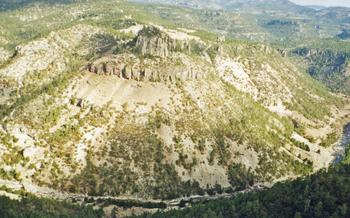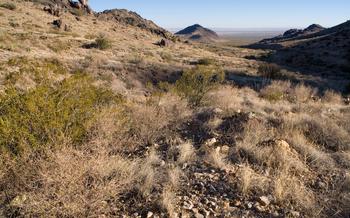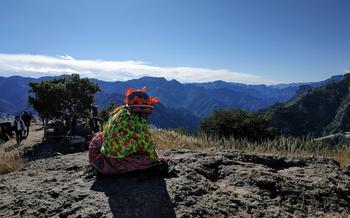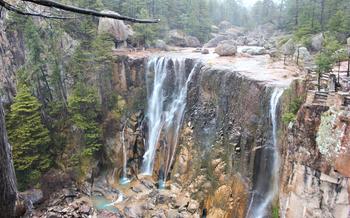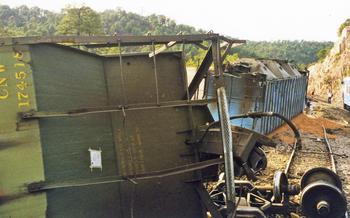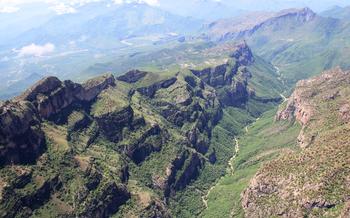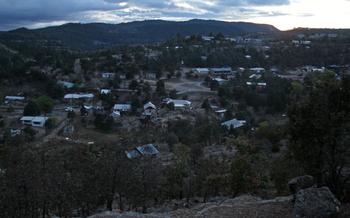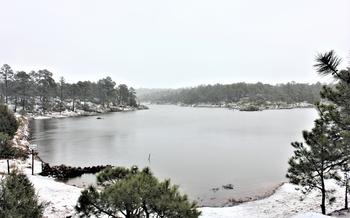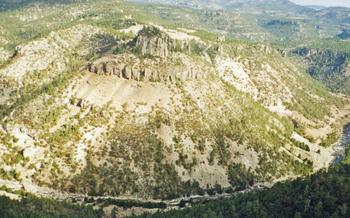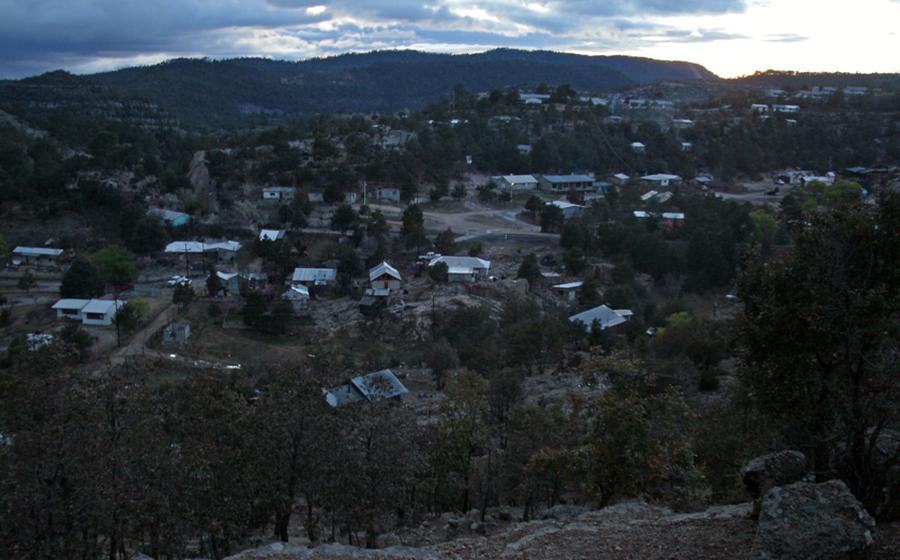
Río Mayo
- The Río Mayo: A Hidden Gem in Mexico’s Copper Canyon
- Getting There: Adventure Awaits
- Accommodations: Rest and Relaxation
- Exploring the River: A Journey of Discovery
- The Majestic Canyons: Awe-Inspiring Vistas
- Cultural Encounters: Unveiling Traditions
- The Mission of San Bernardo: A Historic Landmark
- Cascada de Basaseachi: Nature’s Masterpiece
- The Town of Creel: A Charming Base
- The Cave of the Olla: An Archaeological Wonder
- The Valley of the Mushrooms: A Natural Curiosity
- The Tarahumara People: Guardians of the Land
- Gastronomic Delights: A Culinary Adventure
- Off-the-Beaten-Path Gems: Hidden Treasures
- Insider Tip: Timing is Everything
The Río Mayo: A Hidden Gem in Mexico’s Copper Canyon
In the heart of Mexico's majestic Copper Canyon, a tributary of the Fuerte River called the Río Mayo meanders through a breathtaking landscape, carving its way through towering canyons, lush forests, and ancient rock formations. This hidden gem is a true adventurer's paradise, offering a diverse range of natural and cultural experiences that will leave you in awe. The Mayo River has played a vital role in shaping the region's ecosystem and cultural heritage, serving as a lifeline for local communities and providing sustenance and inspiration for generations. Its banks are adorned with diverse flora and fauna, including towering pines, cascading waterfalls, and an abundance of wildlife, making it a haven for nature enthusiasts and birdwatchers alike. As you journey along the river, you'll encounter indigenous communities who have preserved their rich traditions and customs, welcoming visitors with open arms and sharing their stories and way of life.
Getting There: Adventure Awaits
Reaching the Río Mayo is an adventure in itself, offering a variety of options to suit different preferences. The region is accessible by road, rail, and air, allowing travelers to tailor their journey to their budget and time constraints.
By Road:
The Copper Canyon region is connected by a network of scenic roads, providing a breathtaking drive through the rugged landscapes. The primary routes include Highway 16 from Chihuahua and Highway 17 from Los Mochis. These roads offer stunning views of the canyons, valleys, and diverse ecosystems along the way.
By Rail:
For a truly unique experience, consider taking the El Chepe train, which runs through the heart of the Copper Canyon. This iconic train journey offers panoramic views of the canyons, passing through tunnels, bridges, and along the winding tracks that hug the steep cliffs.
By Air:
The nearest major airport to the Río Mayo is the Chihuahua International Airport (CUU). From here, travelers can take connecting flights to the regional airports of Creel or Los Mochis, which provide access to the canyon region.
Scenic Routes and Transportation Options:
To fully immerse yourself in the beauty of the Copper Canyon, consider renting a car or hiring a local guide for a personalized tour. This allows for flexibility and the freedom to explore at your own pace, stopping at viewpoints, hidden gems, and local communities along the way.
Planning Your Trip and Budgeting:
Plan your trip carefully, taking into account the time of year, duration of your stay, and budget. Accommodation options range from rustic cabins and hostels to luxurious lodges, catering to different budgets and preferences.
Transportation costs vary depending on the mode of travel and the distance covered. Guided tours and excursions can be arranged through local tour operators or directly with hotels and lodges.
Accommodations: Rest and Relaxation
Along the Río Mayo, you'll find a range of lodging options to suit every traveler. From rustic cabins and charming bed and breakfasts to luxurious ecolodges and boutique hotels, there's something for every budget and preference.
For a truly immersive experience, consider staying in one of the many ecolodges that dot the region. These lodges offer a unique blend of comfort and sustainability, with private cabins or bungalows nestled amidst stunning natural surroundings. Enjoy breathtaking views, eco-friendly amenities, and guided tours that showcase the region's rich biodiversity.
No matter where you choose to stay, you'll find warm hospitality and personalized service. Many accommodations offer additional amenities such as on-site restaurants, swimming pools, and spas, ensuring a relaxing and rejuvenating stay.
To secure your desired accommodation, especially during peak season, it's advisable to book in advance. Online booking platforms and local travel agents can assist you in finding the perfect place to rest and recharge after a day of exploring the wonders of the Río Mayo.
Exploring the River: A Journey of Discovery
The Río Mayo offers a wealth of opportunities for adventure and exploration. Whether you prefer guided tours or self-guided adventures, there are plenty of ways to discover the river's hidden gems.
Kayaking and rafting are popular ways to navigate the river's calm waters, allowing you to immerse yourself in the stunning scenery and spot wildlife along the banks. For those seeking a more leisurely experience, boat excursions offer a relaxing way to take in the sights and sounds of the river.
Fishing enthusiasts will delight in the abundance of trout and bass that inhabit the river's waters. Swimming is also a popular pastime, with designated swimming areas and crystal-clear waters inviting you to take a refreshing dip.
Wildlife enthusiasts will be in their element, as the river is home to a diverse array of birdlife, including eagles, hawks, and herons. Keep an eye out for other animals, such as deer, raccoons, and beavers, that frequent the river's banks.
Before embarking on your river adventure, be sure to familiarize yourself with safety precautions and regulations. Always wear a life jacket when on the water, and be aware of the river's currents and potential hazards. Respect the natural environment and leave no trace, ensuring that the river remains pristine for future generations.
The Majestic Canyons: Awe-Inspiring Vistas
The Río Mayo is home to some of the most breathtaking canyons in Mexico. The region is characterized by its rugged landscapes, towering cliffs, and deep gorges. The canyons were formed over millions of years by the relentless flow of the river, carving its way through the rock. The result is a series of natural wonders that are a sight to behold.
Geological Formations and Unique Landscapes
The Río Mayo canyons are a testament to the power of nature. The river has carved its way through layers of rock, creating a variety of geological formations. These include towering cliffs, sheer rock faces, and deep gorges. The canyons are also home to a variety of unique landscapes, including mesas, buttes, and spires.
Hiking Trails and Viewpoints
There are several hiking trails that wind through the Río Mayo canyons. These trails offer hikers the opportunity to experience the canyons up close and personal. Along the trails, you'll find stunning viewpoints that offer panoramic vistas of the surrounding landscape.
Photography Opportunities and Scenic Spots
The Río Mayo canyons are a photographer's paradise. The region is home to an abundance of scenic spots, including waterfalls, rivers, and mountains. Whether you're a professional photographer or simply someone who enjoys taking pictures, you'll find plenty of opportunities to capture stunning images in the Río Mayo canyons.
Responsible Tourism and Conservation Efforts
The Río Mayo canyons are a fragile ecosystem. It's important to practice responsible tourism when visiting the region. This means staying on designated trails, not littering, and respecting the wildlife. There are also several conservation efforts underway to protect the canyons and their unique ecosystems.
Cultural Encounters: Unveiling Traditions
The Copper Canyon is home to a diverse array of indigenous communities, each with its own unique culture and traditions. The most prominent group is the Tarahumara, also known as the Rarámuri, who have inhabited the region for centuries. Their way of life is closely intertwined with the land, and they have a deep respect for nature. Visitors can interact with the Tarahumara people and learn about their traditions through guided tours, cultural workshops, and homestays.
Local festivals, music, and handicrafts offer a vibrant glimpse into the cultural heritage of the region. The Copper Canyon is renowned for its traditional music, which is often performed at festivals and gatherings. Visitors can also witness the creation of intricate handicrafts, such as woven baskets, pottery, and textiles, which are often sold at local markets.
The culinary delights of the Copper Canyon are not to be missed. The region's cuisine is a blend of indigenous and Mexican flavors, and features fresh, local ingredients. Must-try dishes include barbacoa, a slow-cooked meat dish, and gorditas, a type of thick tortilla filled with various ingredients. Visitors can also indulge in traditional drinks like tesgüino, a fermented corn beverage, and sotol, a distilled spirit made from the desert spoon plant.
By interacting with the locals and immersing themselves in the cultural experiences of the Copper Canyon, visitors can gain a deeper understanding of the region's rich heritage and traditions.
The Mission of San Bernardo: A Historic Landmark
Amidst the breathtaking natural wonders of the Copper Canyon lies a hidden gem of colonial architecture - the Mission of San Bernardo. Established in the 17th century by Jesuit missionaries, this historic landmark stands as a testament to the region's rich religious heritage and cultural fusion.
The mission boasts an impressive façade, adorned with intricate carvings and sculptures that blend indigenous and European influences. Its interior, though simple, exudes a sense of tranquility and devotion, with its vaulted ceilings, arched doorways, and ornate altar.
Guided tours are available, providing visitors with insights into the history and significance of this sacred site. Explore the mission's well-preserved structures, including the church, the courtyard, and the living quarters, and learn about the challenges and triumphs faced by the early missionaries and the indigenous communities they served.
Remember to bring your camera to capture the architectural beauty of the mission and the stunning backdrop of the surrounding canyons. Respect the sanctity of this religious site by adhering to appropriate dress code and maintaining a reverent demeanor.
Cascada de Basaseachi: Nature’s Masterpiece
In the heart of the Copper Canyon lies a natural wonder that draws visitors from around the globe – the Cascada de Basaseachi. Plunging over 246 meters, it ranks among Mexico’s highest waterfalls and is a testament to the region's awe-inspiring beauty. Surrounded by lush vegetation and towering cliffs, the waterfall cascades into a pool of crystal-clear water, creating a mesmerizing spectacle.
The journey to Cascada de Basaseachi is an adventure in itself. Visitors can embark on a scenic hike through the rugged canyon trails, passing by cascading rivers and ancient rock formations. Along the way, they may encounter local artisans selling handmade crafts and regional delicacies. The hike culminates in a breathtaking view of the waterfall, where the thunderous roar of the water fills the air.
A visit to Cascada de Basaseachi is not just about witnessing its grandeur but also about connecting with nature and appreciating its pristine beauty. Visitors can take a refreshing dip in the pool below the waterfall, enjoy a picnic lunch surrounded by stunning scenery, or simply relax and soak in the tranquility of the surroundings.
To ensure a responsible and sustainable visit, it is important to follow designated trails, avoid disturbing the local flora and fauna, and dispose of waste properly. The waterfall is a fragile ecosystem, and visitors are encouraged to leave no trace and respect the natural environment.
Cascada de Basaseachi is more than just a waterfall; it is a symbol of the Copper Canyon's untamed beauty and a reminder of the power and majesty of nature. Whether you're a nature enthusiast, an adventure seeker, or simply someone looking for a breathtaking experience, this natural wonder is sure to leave you in awe.
The Town of Creel: A Charming Base
Nestled amidst the majestic Copper Canyon, the charming town of Creel serves as an ideal base for adventurers seeking to explore the region's natural wonders and rich cultural heritage. With its captivating blend of history, culture, and natural beauty, Creel offers a wealth of experiences that are sure to captivate visitors.
Accommodation options in Creel range from cozy bed and breakfasts to luxurious lodges, providing travelers with a comfortable and convenient stay. The town's vibrant dining scene offers a tantalizing array of culinary delights, from traditional Mexican fare to international cuisine. Creel is also a shopper's paradise, with its bustling markets and boutiques selling an eclectic mix of artesanía, souvenirs, and regional products.
Beyond its commercial offerings, Creel boasts several cultural attractions and historical sites that shed light on the region's rich past. The Museo Comunitario de Creel showcases fascinating exhibits on the local indigenous cultures, while the Templo de San Ignacio, a beautiful 19th-century church, stands as a testament to the town's colonial heritage.
Creel serves as a gateway to numerous excursions and day trips that allow visitors to delve deeper into the wonders of the Copper Canyon. Guided tours to the nearby Cascada de Basaseachi, one of Mexico's highest waterfalls, offer breathtaking views and an unforgettable experience. The town is also an excellent starting point for exploring the surrounding canyons and valleys, with hiking trails that cater to all levels of fitness and experience.
In Creel, visitors can immerse themselves in the local culture and traditions through interactions with the friendly and welcoming Tarahumara people. The town hosts regular festivals and events that showcase indigenous music, dance, and handicrafts, providing a glimpse into the vibrant cultural heritage of the region.
Whether you seek adventure, history, culture, or simply a relaxing escape, Creel offers an enchanting experience that will leave an enduring impression. So, pack your bags, embrace the spirit of exploration, and let the allure of Creel captivate your senses.
The Cave of the Olla: An Archaeological Wonder
Deep within the rugged landscapes of the Copper Canyon lies a hidden treasure called the Cave of the Olla. This ancient cave holds significant historical and cultural value, showcasing a remarkable collection of rock art and petroglyphs created by indigenous civilizations centuries ago. The cave's intricate designs and symbols offer a glimpse into the past, providing insights into the beliefs, traditions, and artistic expressions of the region's earliest inhabitants.
Exploring the Cave of the Olla is a journey through time, allowing visitors to connect with the rich cultural heritage of the region. Guided tours are available, led by knowledgeable guides who share fascinating stories and explanations about the cave's significance. Visitors can marvel at the well-preserved petroglyphs, which depict various figures, animals, and scenes from everyday life. The cave's acoustics also add to its allure, creating a unique and immersive experience for visitors.
Preservation and conservation efforts are paramount at the Cave of the Olla. Visitors are encouraged to respect the cave's delicate ecosystem and refrain from touching or damaging the rock art. Sustainable tourism practices are implemented to protect this natural and cultural wonder for future generations.
Whether you're a history buff, an art enthusiast, or simply seeking a unique and awe-inspiring experience, the Cave of the Olla should be on your itinerary when exploring the Copper Canyon. Its ancient rock art and cultural significance make it a must-visit destination for those seeking a deeper connection to the region's rich past.
The Valley of the Mushrooms: A Natural Curiosity
In the heart of Mexico’s Copper Canyon lies a geological marvel known as the Valley of the Mushrooms. This enchanting landscape is dotted with unique rock formations that resemble giant mushrooms, creating a surreal and awe-inspiring sight. The valley is a testament to the powerful forces of nature and the intricate processes of weathering that have shaped this extraordinary terrain.
The Valley of the Mushrooms is a relatively new discovery, having only been brought to the attention of the outside world in the late 1990s. Since then, it has become a popular destination for hikers, photographers, and nature enthusiasts who are drawn to its unique beauty and geological significance.
The rock formations in the valley are known as hoodoos, which are tall, thin spires of rock that are formed by the erosion of softer underlying material. In the case of the Valley of the Mushrooms, the hoodoos have been carved out of a layer of volcanic tuff, which is a type of rock formed from the ash and debris of volcanic eruptions.
Over time, the tuff has been weathered and eroded by wind, rain, and other natural forces, creating the distinctive mushroom-shaped structures. The valley is home to hundreds of these hoodoos, ranging in size from a few feet to over 50 feet in height.
Hiking through the Valley of the Mushrooms is a unique and unforgettable experience. The trails wind through a landscape that is both beautiful and otherworldly, with the towering hoodoos creating a sense of wonder and awe. Visitors can explore the valley at their own pace, stopping to admire the rock formations, take photographs, or simply soak in the tranquility of the surroundings.
The Valley of the Mushrooms is a reminder of the incredible diversity and beauty of Mexico’s natural landscapes. It is a place where visitors can come to appreciate the power of nature and the intricate processes that have shaped our planet.
The Tarahumara People: Guardians of the Land
The Copper Canyon is also home to the fascinating Tarahumara people, an indigenous community that has inhabited the region for centuries. They are renowned for their deep connection to the land, sustainable living practices, and unique cultural traditions.
The Tarahumara, also known as the Rarámuri, have a rich cultural heritage that is deeply intertwined with the natural environment. They possess an extensive knowledge of medicinal plants, traditional agricultural techniques, and hunting and gathering practices that have allowed them to thrive in the rugged terrain.
Their craftsmanship is another remarkable aspect of their culture. The Tarahumara are skilled artisans who create intricate textiles, pottery, and jewelry using traditional methods and natural materials. These handicrafts not only showcase their creativity but also serve as a source of income and cultural preservation.
Interacting with the Tarahumara people is a truly enriching experience. They are known for their warm hospitality, welcoming visitors into their communities and sharing their customs and traditions. Homestays and cultural tours offer a unique opportunity to learn about their way of life, participate in traditional ceremonies, and support local initiatives.
It is important to approach encounters with the Tarahumara with respect and cultural sensitivity. Visitors should seek permission before entering their villages and sacred sites and avoid taking photographs without their consent. By respecting their privacy and traditions, you can contribute to the preservation of their unique culture while fostering meaningful connections and cultural exchange.
Gastronomic Delights: A Culinary Adventure
In the heart of Mexico's Copper Canyon lies a culinary paradise waiting to be discovered. The region boasts a rich gastronomic heritage, deeply rooted in local traditions and the bounty of the land. From mouthwatering regional dishes to unique ingredients and cooking techniques, a culinary adventure in the Copper Canyon is a journey for the senses.
Must-try dishes include the iconic machaca con huevos, a hearty breakfast dish made with shredded beef and eggs, and caldo de res, a traditional beef stew brimming with flavor. For a taste of local delicacies, sample quesadillas de flor de calabaza, stuffed with edible squash blossoms, or enchiladas del suelo, a regional specialty made with corn tortillas filled with cheese and smothered in a savory sauce.
Local ingredients are the heart of the Copper Canyon cuisine. Freshly harvested vegetables, aromatic herbs, and locally raised meats and cheeses come together to create dishes that are both authentic and delicious. Don't miss the chance to savor the region's flavorful queso Chihuahua, a semi-hard cheese known for its rich and creamy texture.
For a truly immersive experience, participate in a cooking class or culinary workshop. Learn the secrets behind traditional recipes and discover the art of Mexican cooking from local experts. These hands-on experiences offer a unique opportunity to connect with the region's culinary heritage and create lasting memories.
Whether you prefer to indulge in local delicacies at charming restaurants or embark on a culinary adventure in the comfort of your own kitchen, the Copper Canyon promises an unforgettable gastronomic journey. So come hungry, savor the flavors, and let the region's cuisine transport you to a world of culinary wonders.
Off-the-Beaten-Path Gems: Hidden Treasures
Beyond the popular attractions, the Río Mayo region offers a plethora of hidden gems waiting to be discovered. Venture off the beaten path and explore lesser-known spots that showcase the area's unique charm and beauty. Discover secluded beaches where you can soak up the sun and tranquility, or take a refreshing dip in natural pools surrounded by stunning scenery. Embark on a hike to find hidden waterfalls and viewpoints that offer breathtaking panoramas of the region.
Uncover the secrets of the local culture by visiting traditional villages and markets where you can interact with the friendly locals and purchase unique handicrafts. Support sustainable tourism by choosing locally-owned restaurants and accommodations, ensuring that your travels benefit the community. Explore ancient ruins and historical sites that provide a glimpse into the region's rich past. With so much to offer, the Río Mayo region is an ideal destination for travelers seeking authentic experiences and hidden treasures.
Insider Tip: Timing is Everything
The best time to visit the Río Mayo is during the dry season, which runs from October to May. During this time, the weather is generally sunny and mild, with average temperatures ranging from 60 to 80 degrees Fahrenheit. The river levels are also lower, making it easier to explore and enjoy the various water activities.
Avoid visiting during the rainy season, which lasts from June to September, as the heavy rains can make it difficult to travel and can cause flooding. Additionally, some attractions and activities may be closed or limited during this time.
Plan your trip in advance to avoid crowds and to take advantage of special events and festivals. The Copper Canyon Ultramarathon, held annually in March, is a popular event that attracts runners from all over the world. The Semana Santa (Holy Week) celebrations in April are also a major attraction, with colorful processions and religious ceremonies taking place in towns and villages throughout the region.
Be prepared for all types of weather, as the climate in the Copper Canyon can be unpredictable. Bring layers of clothing, a raincoat or umbrella, and comfortable shoes for hiking. It's also important to stay hydrated and to protect yourself from the sun by wearing sunscreen and a hat.
